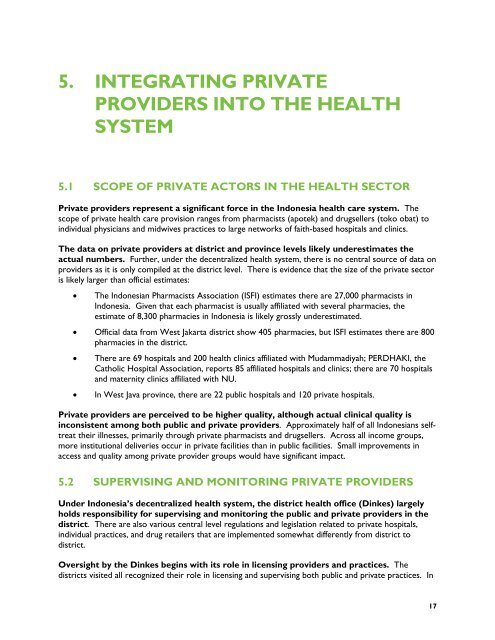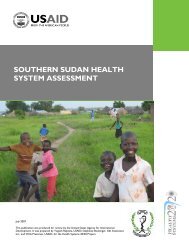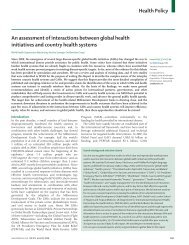PRIVATE SECTOR HEALTH CARE IN INDONESIA - Health Systems ...
PRIVATE SECTOR HEALTH CARE IN INDONESIA - Health Systems ...
PRIVATE SECTOR HEALTH CARE IN INDONESIA - Health Systems ...
- No tags were found...
Create successful ePaper yourself
Turn your PDF publications into a flip-book with our unique Google optimized e-Paper software.
5. <strong>IN</strong>TEGRAT<strong>IN</strong>G <strong>PRIVATE</strong>PROVIDERS <strong>IN</strong>TO THE <strong>HEALTH</strong>SYSTEM5.1 SCOPE OF <strong>PRIVATE</strong> ACTORS <strong>IN</strong> THE <strong>HEALTH</strong> <strong>SECTOR</strong>Private providers represent a significant force in the Indonesia health care system. Thescope of private health care provision ranges from pharmacists (apotek) and drugsellers (toko obat) toindividual physicians and midwives practices to large networks of faith-based hospitals and clinics.The data on private providers at district and province levels likely underestimates theactual numbers. Further, under the decentralized health system, there is no central source of data onproviders as it is only compiled at the district level. There is evidence that the size of the private sectoris likely larger than official estimates:• The Indonesian Pharmacists Association (ISFI) estimates there are 27,000 pharmacists inIndonesia. Given that each pharmacist is usually affiliated with several pharmacies, theestimate of 8,300 pharmacies in Indonesia is likely grossly underestimated.• Official data from West Jakarta district show 405 pharmacies, but ISFI estimates there are 800pharmacies in the district.• There are 69 hospitals and 200 health clinics affiliated with Mudammadiyah; PERDHAKI, theCatholic Hospital Association, reports 85 affiliated hospitals and clinics; there are 70 hospitalsand maternity clinics affiliated with NU.• In West Java province, there are 22 public hospitals and 120 private hospitals.Private providers are perceived to be higher quality, although actual clinical quality isinconsistent among both public and private providers. Approximately half of all Indonesians selftreattheir illnesses, primarily through private pharmacists and drugsellers. Across all income groups,more institutional deliveries occur in private facilities than in public facilities. Small improvements inaccess and quality among private provider groups would have significant impact.5.2 SUPERVIS<strong>IN</strong>G AND MONITOR<strong>IN</strong>G <strong>PRIVATE</strong> PROVIDERSUnder Indonesia’s decentralized health system, the district health office (Dinkes) largelyholds responsibility for supervising and monitoring the public and private providers in thedistrict. There are also various central level regulations and legislation related to private hospitals,individual practices, and drug retailers that are implemented somewhat differently from district todistrict.Oversight by the Dinkes begins with its role in licensing providers and practices. Thedistricts visited all recognized their role in licensing and supervising both public and private practices. In17
















